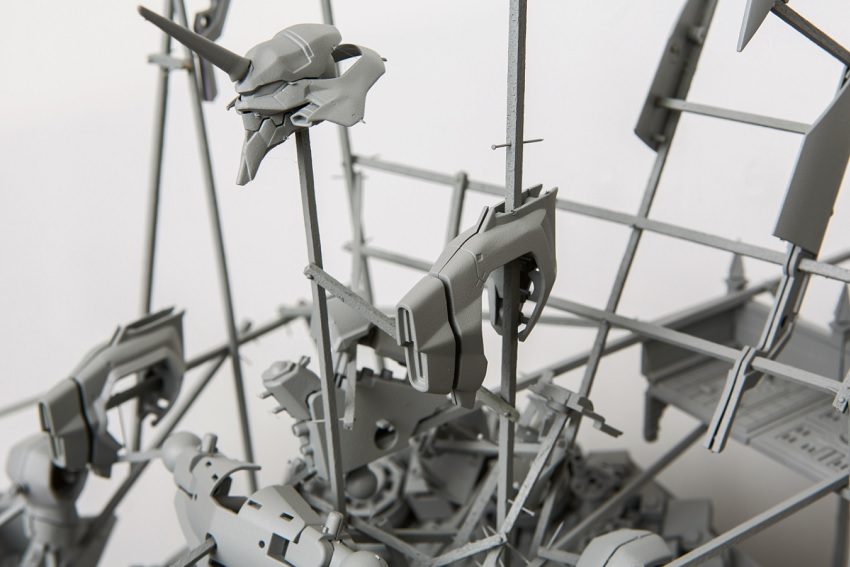Roy Ananda Comes Out To Play

Roy Ananda’s playful and honest work at Hugo Michel Gallery explores the crossroad and the fun of being a pop-culture fanatic as well as a practising artist.
Imagine reading this death notice in the paper.
‘EXHAM of FARLOFT/perished in the Red Steppes attempting to free a caravan of slaves on route to the Eastern Satrapies/ Into the arms of the Stern Lady Wee Jas, Ruby Sorceress and Death’s Guardian we recommend our brother.’
You never will because the artist responsible for this text, Roy Ananda, weighed the sensitivities of lodging it within a ‘real’ deaths column and has plumped for the more forgiving of circumstances – an art gallery – where as we all know, anything goes. Besides, an alert sub editor would have smelled a rat (or Ranger/Second Level Fighter) several Farloftian leagues away.
So what’s this all about? Anandian Companions have long since abandoned speculation about the real message or intent in the artist’s work. To over-analyse is to miss the point – or more particularly, the fun.
 ‘Death notice’ 2016. Digital print on newsprint. Photo: Sam Roberts
‘Death notice’ 2016. Digital print on newsprint. Photo: Sam Roberts
Ananda’s constructions are funny not simply because he finds them so but because he continues to find ways to create situations which encourage the viewer to enter into the game. A recent example is a pair of rapiers, suspended from fine wires and striking each other as if in a duel.
Shades of swashbuckling cinematic moments but also a subtle referencing of Alexander Calder mobiles. Another example is the reprise of Star Wars’ iconic opening credits (‘In a galaxy far away’) incongruously constructed from timber framing and plywood cut outs. If this is fun then what kind of response is appropriate? Maybe laughter.
But should it be mirthless, hollow, bitter or ironic? I’d settle for ‘knowing’ – more an inner one-handclapping of a joke successfully pulled off. Ananda remains conscious of the perils of the one-liner while testing its boundaries in a series of earlier works which played out as physical analogues of cartoon escapades like ACME explosions and Road Runner gotcha moments.
 ‘Composition for three kit models’ 2016. Kit model components, balsa, fixings, acrylic paint. Photo: Sam Roberts
‘Composition for three kit models’ 2016. Kit model components, balsa, fixings, acrylic paint. Photo: Sam Roberts
He admits that in doing so he was always looking for ways to de ect the ‘kaboom’ moment when all is revealed. The result has been a pathos or poignancy which lends his practice a sense of vulnerability.
This is particularly apparent in work currently exhibited where Ananda appears to be hanging his inner fantasies and self-styled boyish enthusiasms out to dry. This is fandom territory as critiqued through the Filter of One Who Is Possessed.
The artist occasionally hangs out with other fantasists who enjoy a bit of LARPing (live action roleplay). While he may not be up to travelling on the Gawler train after dark dressed as a Level 7 Dark Necromancer, he does feel some kinship with folk who value play and make-believe and defy the homogeneity of urbanised life. Ananda’s alignment is tangential.
He casts himself as a pop culture tragic who’s got a feeling that he can’t let go. The sound work in this exhibition is a case in point. It consists of overlapping commentaries of Clive Barker’s 1987 body horror movie Hellraiser – a particular favourite of the artist.
 ‘Composition for three kit models’ 2016. Kit model components, balsa, fi xings, acrylic paint. Photo: Sam Roberts
‘Composition for three kit models’ 2016. Kit model components, balsa, fi xings, acrylic paint. Photo: Sam Roberts
The commentaries juxtapose gush, critical analysis and fanzine trivia. The artist appears to be approximating the complexities of experiencing the movie as a visceral and cerebral event. A similar dynamic is apparent in an annotated section of an H.P. Lovecraft text.
Displayed on the gallery wall this item imitates the self–referencing portentousness of ‘70s conceptual art. But if the viewer persists, a sense of authenticity emerges from the obsessive commentaries, created by the artist.
This earnestness de fines Ananda’s practice as somehow impossibly heroic and authentic. As he comments, “I actually love all this stuff”. He speaks for many.
Roy Ananda Hugo Michell Gallery ursday, September 8 to Saturday, October 8 hugomichellgallery.com